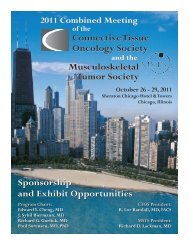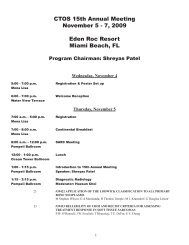207 Poster Session 2 - Connective Tissue Oncology Society
207 Poster Session 2 - Connective Tissue Oncology Society
207 Poster Session 2 - Connective Tissue Oncology Society
You also want an ePaper? Increase the reach of your titles
YUMPU automatically turns print PDFs into web optimized ePapers that Google loves.
Scientific <strong>Poster</strong>s – <strong>Poster</strong> <strong>Session</strong> 2Methods: Twelve sarcoma radiation oncologists wereprovided with co-registered preoperative T1 gadoliniumenhanced and T2-weighted MR images of 10 patients withhigh-grade extremity STS (MPNST, leiomyosarcoma, liposarcoma,myxofibrosarcoma, and undifferentiated sarcoma).Gross tumor had been contoured by a single observerand provided with the co-registered image sets. Suspiciousperi-tumoral edema was independently delineated by 12radiation oncologists based on abnormal T2 signal. MRdata with the edema contours were then returned for centralanalysis. CTV3cm (3cm longitudinal and 1.5cm radialmargin) and CTV2cm (2cm longitudinal and 1cm radialmargin) were delineated by a single observer (geometricexpansions trimmed to anatomic barriers). Analysis ofcontouring agreement between edema contours was performedusing the Simultaneous Truth and PerformanceLevel Estimation (STAPLE) algorithm and kappa statisticof a Matlab/CERR consensus tool.Results: The mean volumes of GTV, CTV2cm and CTV3cmwere respectively 130cc (range: 7-413cc), 306cc (range: 53-860cc) and 360cc (range: 91-1055cc). The mean consensusvolume of suspicious edema computed using the STAPLEalgorithm at 95% confidence interval (STAPLE95) was 58cc(range: 4-182cc) with a substantial overall agreement correctedfor chance (mean kappa=0.73; range: 0.36–0.89). Themedian volume of suspicious edema not included in theanatomical CTV2cm was 5cc, 0.3cc for the CTV3cm. Therewere 3 large tumors with >30cc of suspicious edema notincluded in the CTV3cm volume. A median of 96.8% of theSTAPLE95 edema volume was found within the anatomicalCTV2cm (99.7% within the CTV3cm).Conclusion: A substantial or near-perfect inter-observeragreement was observed in suspicious edema delineationin most cases of high-grade STS of the extremity. Inaddition, suspicious edema was encompassed within theCTV2cm volumes for the preponderance of cases. For onlya minority of cases, significant expansion of these CTVswas required to cover suspicious edema.Acknowledgement: this study was supported in part byNIH U24 grant CA81647<strong>Poster</strong> #163LOCO-REGIONAL RECURRENCE AFTERPRE-OPERATIVE RADIATION THERAPY FORRETROPERITONEAL SARCOMA AND THEPOTENTIAL BENEFIT OF DOSE ESCALATIONUSING DOSE PAINTINGSean M. McBride, MD, MPH 1 ; Chandrajit P. Raut 2 ;Michelle Lapidus 2 ; Phillip M. Devlin3; Karen J. Marcus 3 ;Monica Bertagnolli 2 ; Suzanne George 4 ; Elizabeth H. Baldini 31Radiation <strong>Oncology</strong>, Harvard Radiation <strong>Oncology</strong> Program,Boston, MA, USA; 2 Surgical <strong>Oncology</strong>, Brigham andWomen’s Hospital, Boston, MA, USA; 3 Radiation <strong>Oncology</strong>,Dana Farber Cancer Institute, Brigham and Women’sHospital, Boston, MA, USA; 4 Medical <strong>Oncology</strong>,Dana-Farber Cancer Institute, Boston, MA, USAObjective: Loco-regional recurrence (LRR) rates followingpre-operative radiation (RT) and radical resection for retroperitonealsarcoma are high. Dose escalation using dosepainting has been proposed as a means to decrease LRRbut is reasonable only if LRR is occurring within the RTfield. We analyzed LRR locations with respect to RT fieldsto determine the potential benefit of dose escalation.Methods: We reviewed records of 33 patients treated withpre-operative RT and resection between 2002 and 2011. LRRimaging was compared to CT-based RT dosimetry plans.We determined tumor volumes appropriate for a dosepaintingboost and identified the number of recurrenceswithin this volume. Clinical and pathologic variables predictiveof overall survival (OS), freedom from progression(FFP), LRR, and distant recurrence (DR) were evaluated.Log-rank and Gray’s tests were used for univariate testingand Cox proportional hazards regression and competingrisk regression were used for multivariate analysis.Results: Twenty-four patients (73%) were treated at initialpresentation and 9 (27%) at the time of recurrent disease.Median pre-operative RT dose was 50 Gy (range, 43.2-50.4).Ten patients received induction chemotherapy and 10 receivedintra-operative brachytherapy. Histologies includedde-differentiated liposarcoma (16), leiomyosarcoma (12),and other (5). Median follow-up for the 33 patients was 32.9months and median OS was 53.8 months. At 1 and 3 years,OS rates were 87% and 64%, FFP rates were 71% and 45%,cumulative incidences of LRR were 19% and 37% and DRwere 13% and 21%. On univariate analysis, recurrent diseasestatus at the time of presentation and de-differentiatedliposarcoma histology predicted for increased LRR rates.On multivariate analysis, only recurrent disease remainedsignificant. Sixteen patients relapsed. At first relapse, 6patients had isolated LR, 2 isolated RR, 6 isolated DR, 1synchronous LR and RR, and 1 synchronous LR, RR andDR. Four patients had isolated in-field recurrences, all inareas that would have been boosted using dose painting.Conclusion: Because only a small proportion of retroperitonealsarcoma recurrences are within the potential boostfields, dose escalation with dose painting may only benefita limited subset of patients.252






